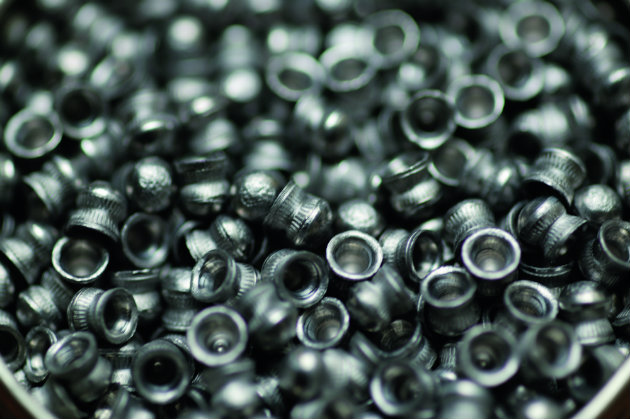We put some of the best 177 hunting pellets to the test to find the best airgun ammunition.
The smaller 177 calibre has long been neglected by hunters as an ineffective pest pellet. The reasoning behind this is easy to understand, more mass = more power but this not strictly true as power is actually a relationship between mass and speed. Think about it this way, if I were to throw a tennis ball at a window, chances are it bounces straight off but if I were to launch a steel ball bearing at that same window through a sling shot it would punch a hole clean through despite the BB having much less mass than the tennis ball. This is because of the greater speed.
The UK limit for muzzle energy on an air rifle is 12ft/lb no matter what the mass of the pellet is. This equates to ~500fps in a .22 and ~700 – 750fps in a .177, around 50% higher! This added speed means that under the right conditions a 4.5mm pellet can be just as, if not more effective than a .22.
OK, with that out of the way, what criteria are we actually looking for? What makes an effective hunting pellet? When hunting any live animal, the most important factor to keep in mind is respect for the quarry and to minimise suffering. Therefore, the most important thing we are looking to achieve is a reliable one shot dispatch. This is usually achieved via a head shot but can also be possible via a heart and lung shot with the right pellet. Let’s see if we can find it with some of the options below.
All pellets tested with .177 Zbroia Hortitsia running at between 11.5 – 11.7 ft/lb at ranges between 20m – 35m. (Edit Nov 2024 – unfortunately this rifle is no longer available but click here to see our .177 rifle range)
H&N Barracuda Hunter Extreme

Made by H&N, these pellets are some of the most effective one shot pellets that money can buy. Normally in sub 12ft/lb airguns, expansion of hollow points is something that is actually quite hard to achieve as the velocities involved are not high enough to deform the lead, even in the faster .177 calibre. With the H&N Baracuda Hunter Extreme all of this is flipped on it’s head thanks to the cross shaped hollow points that these pellets feature. The ingenuity of this design allows the pellet to mushroom out upon impact as contact with the target creates a pocket of air that, instead of pressing against a thick wall of lead surrounding the hollow point, instead is forced against four thinner walls and allows for rapid expansion even in lower velocities. This leads to a much larger wound channel and more of the pellets energy being transferred into the target. This is what we want and what this translates to is, not only will a head shot be enough to reliably kill vermin in our desired one shot, but also a heart and lung shot will be more than capable.

The sacrifice that is made with this shape is long range & potential accuracy. The hollow point of the pellet whilst perfect for dispatch actually works against the pellet in flight and increases the air resistance, reducing range and causing the pellets to drop sooner than some of the more traditionally shaped diabolos. This has to be factored in whilst aiming as your point of impact might be slightly lower than expected, even if zeroed with domed pellets at the same weight.
Something else to consider is these pellets are not the cheapest on the market and they also only come in tins of 400 as opposed to the usual 500 for other .177s. Still a potential of 400 pigeons in the pot so I’m not really complaining.
QYS Domed
For this test I am using the lighter 8.18 grain QYS Domed pellets as opposed to the 9.56 version. My reasoning for testing these is to try something with a lot higher velocity in an attempt push the effective range as far as possible in a .177. Again, our main priority is the quick and consistent one-shot dispatch but a lighter pellet should carry more velocity out of the barrel and therefore maintain that power further downrange.

The uniformity of these pellets surprised me somewhat. The “Made in China ” slur is a brush that QYS are, I think, unfairly tarred with as the consistency in shape, weight and skirt size is absolutely fantastic. The weight deviation in particular was minimal with a maximum deviation of 0.1 grain either side of the advertised 8.18. This consistency is replicated in your shot placement and I found that these QYS pellets were by far the most consistent when zeroing. Now I am not by any means a professional shooter but whilst zeroing these pellets I was able to achieve just over a 25mm (about the size of a 5p) grouping at 30m. Not Bad.
I found the same thing with the pigeons. The trees I camped up in front of were around 35m from me and, when putting the crosshair of the scope on top of the birds head so that the first mill dot lined up with the eye, I was able to reliably one-hit kill birds with a brain shot. Thanks to the lack of expansion and higher speed, there was a degree of over penetration with these pellets though and I could foresee that, unlike the Hunter Extremes pellets listed above, a chest shot would not be enough to kill a pigeon instantly. If you are not confident of hitting heads then I don’t think these are the pellets for you.
H&N Rabbit Magnum II
On the other end of the spectrum are the H&N Rabbit Magnum II pellets that weigh in at a colossal 15.74 grain. Advertised on the tin as being for guns of around 25J these pellets are recommended for FAC power level guns but I know people that shoot the .22 versions of these pellets in 16J guns and swear by them so I thought they’d be worth a shot. Now, my Zbroia Hortitsia is tuned to around 11.7ft/lbs with 10.6 grain Bisley Magnum pellets so just under the 16J limit and way under the recommended level for these pellets and that issue was clearly thrown up by my testing.

These pellets are domed but are shaped more like slugs than traditional diabolo pellets and that added lead at the neck of the pellet is the reason for the increased weight. This design does allow more lead to make contact with the rifling and hopefully increase accuracy, but I was finding that the weight of these pellets was just far too high. I was almost running out of elevation to zero the pellets on my scope (a Hawke Airmax AO 2-7×32) and had to reduce my range to 20m just to reliably hit the target.
The variance between each pellet was OK, the build quality of H&N products is always very good but there was quite a large weight difference between pellets with some being almost half a grain lighter than the advertised 15.74. Now this weight change might not make much of a difference in a high powered gun but when I’m already pushing the limits of my rifle to zero, this variation plays into shot placement quite a lot.

Owing to the unreliable point of impact, I didn’t use these pellets on any birds and I cant recommend you do the same unless you are using an FAC rated airgun and I might have to have a word with my friends using the .22 versions as whether those guns are 16J or not…
RWS Hypermax
And now for something completely different…

So there has been a growing movement in ballistics towards going lead-free. Lead is quite harmful to the environment, even excluding the animals being shot, and has a tendency to build up particularly in water animals and cause severe damage to the food chain. As of 2022, lead shot is not allowed when hunting ducks and other birds and I imagine it won’t be long before this legislation affects pellets. Nothing concrete or confirmed, but call it a hunch. Anyway, thanks to this many pellet manufacturers offer “lead free” pellets in a variety of shapes and sizes. These RWS Hypermax are made from tin and moulded into a pointed shape.

Ok so first thing to say about these pellets is, like most lead alternative pellets, they are extremely light. Weighing in at just 5.2 grain, these pellets are almost half the weight of the Hunter Extreme pellets and through the chronograph the speeds were mind boggling. The hunter extremes were getting about 740fps but some of the Hypermax were getting over 1000fps. Not that far off the speed of sound! I also found that, possibly due to the added hardness of tin compared to lead, the pellets in the tin had low variance in weight and almost no skirt or head deformation, something that can happen to softer lead pellets.

In practice, these perform much like the QYS pellets in that, a head shot is consistent, predictable and effective but the incredible speed and high penetrative power of the pellet means body shots are just going to fly straight through the bird and likely not kill straight away. Also, while testing these pellets the air was relatively still, but lighter pellets tend to be far more affected by the wind which is something to bear in mind.
Tin & alloy pellets are also more expensive than their lead counter parts with this tin costing similar to many others but containing just 200 pellets rather than the usual 500. I understand these tin pellets are relatively new but that’s just not enough for me.
Conclusions
Ok the best performing pellet was the Baracuda Hunter Extreme by H&N but I was surprised by a few, particularly the RWS Hypermax. I do wonder if these lead free pellets become the norm then peoples approach to airgun hunting might change. No longer will you be able to blast a bird or small mammal with a huge lump of lead anywhere in the body and be assured a kill. Instead you will be forced to use a lighter but faster moving projectile that requires a more skilful shot and this would encourage more accuracy and patience when hunting which is always a good thing.

